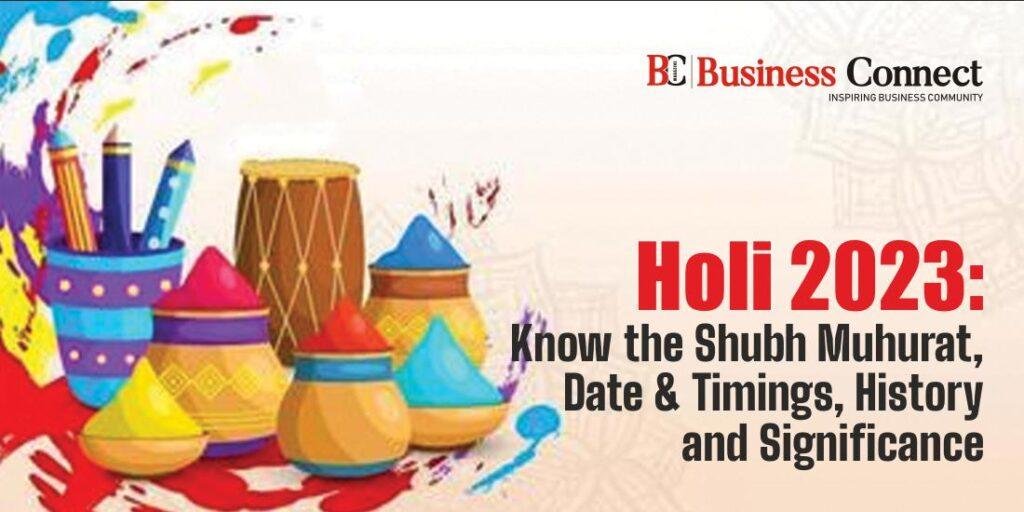Holi 2024: Know the Shubh Muhurat, Date and Timings, History and Significance
Holi is one of the most vibrant and colorful festivals celebrated in India and around the world. It is a festival that signifies the victory of good over evil and the arrival of spring. In 2024, Holi will be celebrated on March 25th, and here’s everything you need to know about the festival, including its history and significance.
The “Festival of Colors,” generally known as Holi, is one of the most colorful and joyful festivals celebrated in India and all across the world. This Hindu festival is observed on the full moon day in the Hindu month of Phalguna, which falls between late February and early March.
Holi Date and Shubh Muhurat
The Holi celebration will take place on March 25, 2024, a Monday. However, Only March 8 will be recognized as Holi Day in all 50 states. When it comes to auspicious occasions, Holika Dahan is performed the day before Holi and called Chhoti Holi. Holika Dahan is concluded when the moon is fully visible. Let us notify you that this time, according to the Panchang, the auspicious time period for Holika Dahan is 2 hours 27 minutes.
On March 24, 2024, from 6:24 to 8:51 in the evening, Holika Dahan can be performed. The date of Holi in 2024 will remain the same; will still be the day. Everyone participates in the holiday of Holi by playing with vibrant colours on the day of the festival. This festival, which is a major celebration for Indian citizens, is observed as a holiday throughout the country. Find out all there is to know about India’s Holi in 2024.
History of Holi
The history of Holi dates back to ancient Hindu mythology and legends. One of the most popular legends is the story of Prahlad, the son of the demon king Hiranyakashipu. According to the legend, Hiranyakashipu was granted a boon by Lord Brahma, which made him virtually indestructible. The demon king became arrogant and demanded that everyone in his kingdom worship him instead of the gods. His own son, Prahlad, on the other hand, refused to honor his father because he was a follower of Lord Vishnu.
Angered by his son’s defiance, Hiranyakashipu tried to kill him several times, but each time Lord Vishnu saved Prahlad. Finally, Lord Vishnu appeared as the half-lion, half-human avatar of Narasimha and killed Hiranyakashipu. The festival of Holi is celebrated to commemorate the victory of good over evil, and the story of Prahlad is seen as an example of unwavering faith and devotion.
The tale of Radha and Krishna is another well-known tradition connected to Holi. According to the legend, Lord Krishna, who had dark blue skin, was jealous of Radha’s fair skin. So, one day, he playfully smeared Radha’s face with colors. The incident became a tradition and is now celebrated as a part of Holi. The festival is a celebration of love, friendship, and the playful nature of Lord Krishna.
The origins of Holi can be traced back to ancient India, where it was known as Holika or Holika Dahan. The festival was celebrated as a thanksgiving for a good harvest and a victory over evil spirits. The festival was also associated with the end of winter and the arrival of spring, which symbolized new beginnings and renewal of life.
During the medieval period, Holi became more prominent in North India, especially in the regions of Mathura and Vrindavan, which are associated with the life of Lord Krishna. The festival was celebrated with great enthusiasm, and people would gather in large numbers to smear each other with colors and play pranks.
In the 17th century, Holi was introduced to the Mughal court by Emperor Jahangir, who was fascinated by the festival’s playful nature. The festival became popular among the Mughal aristocracy and soon spread to other parts of the country. However, during the British colonial period, Holi was frowned upon by the British authorities, who saw it as a primitive and uncivilized practice. Despite this, Holi continued to be celebrated by the Indian people, and the festival became a symbol of resistance against colonial rule.
After India gained independence in 1947, Holi became a national festival, and it is now celebrated with great zeal and enthusiasm across the country. The festival is an occasion for people to come together, forget their differences, and celebrate the joys of life. It is a time when people of all ages and backgrounds gather to play with colors, sing, dance, and feast on traditional delicacies.
Today, Holi is not just celebrated in India but is also observed in many other parts of the world, including Nepal, Pakistan, Bangladesh, and the United States. The festival has become a symbol of India’s cultural diversity and its message of unity and brotherhood has transcended borders.
Celebrations and Traditions
Preparations for Holi begin several days in advance. People clean their homes and decorate them with colorful rangolis (intricate patterns made with colored powder), flowers, and lights. On the day of the festival, people wake up early, wear new clothes, and gather with their family and friends.
One of the most important traditions of Holi is the playing of colors. People throw colored powder (called gulal) and water on each other, and smear each other’s faces with different colors. The colors used in Holi are made from natural ingredients such as flowers, herbs, and spices, and are considered to have medicinal properties.
The playing of colors is accompanied by music, dance, and singing. People dance to the beats of the dhol (a traditional Indian drum) and sing Holi songs. The most popular Holi song is “Rang Barse Bhige Chunar Wali,” which translates to “The color-filled, wet scarf-wearing girl dances in the rain of colors.” The song has become an anthem of sorts for Holi celebrations and is played at almost every Holi party.
Another tradition associated with Holi is the consumption of bhang, a drink made from cannabis leaves. Bhang is an integral part of Holi celebrations and is believed to have medicinal properties. It is consumed in different forms such as thandai (a milk-based drink) and laddoos (a sweet made from flour and cannabis leaves).
Food is an important part of Holi celebrations, and people prepare traditional delicacies such as gujiya (a sweet dumpling filled with khoya and nuts), mathri (a savory snack made from flour), and dahi bhalla (fried lentil balls served with yogurt and chutney). People also indulge in sweets such as rasgulla, gulab jamun, and peda.
In some parts of India, Holi celebrations also include the ritual of Holika Dahan. Holika Dahan is a symbolic burning of the demon Holika, who represents evil. A bonfire is lit the night before Holi, and people gather around it to offer prayers and throw dried leaves and twigs into the fire. The ritual signifies the triumph of good over evil.
In the cities of Mathura and Vrindavan, Holi is celebrated over several days, and the celebrations are particularly colorful and vibrant. The towns are associated with the life of Lord Krishna, and the celebrations include traditional dances such as the Raslila, in which performers enact the love story of Radha and Krishna. The celebrations also include a unique tradition called Lathmar Holi, in which women playfully hit men with sticks and the men protect themselves with shields.
In the state of Punjab, Holi is celebrated as Hola Mohalla, and the celebrations are more subdued and less colorful. The festival is celebrated by the Sikh community and includes military-style parades and martial arts displays.
Here are the top 10 places to celebrate Holi in 2024:
01. Mathura and Vrindavan:

These twin cities in Uttar Pradesh are the birthplace of Lord Krishna and are known for their unique way of celebrating Holi. The celebrations start a week before the actual festival and are known as ‘Lath Maar Holi’ and ‘Phoolon Ki Holi’. The former involves women hitting men with sticks while the latter involves showering each other with flowers.
02. Barsana:
This small town in Uttar Pradesh is famous for its ‘Lath Maar Holi’. Women dress up in traditional attire and beat up men with sticks. The men are supposed to protect themselves with shields. The festival is celebrated with great pomp and show.
03. Jaipur:
The Pink City of India is known for its grand celebrations of Holi. The entire city is painted in different colors and people take to the streets to play with colors and water. The elephant festival is also celebrated during Holi in Jaipur.
04. Udaipur:
The city of lakes is another popular destination to celebrate Holi. The royal family of Udaipur also participates in the celebrations. The festival is celebrated with music, dance, and colors.
05. Hampi:
The ancient city of Hampi in Karnataka is known for its unique way of celebrating Holi. The festival is celebrated with turmeric instead of colors. The yellow color of the turmeric symbolizes the arrival of spring.
06. Shantiniketan:
The university town of Shantiniketan in West Bengal is famous for its Holi celebrations. The festival is celebrated as ‘Basanta Utsav’ or the festival of spring. Students of the university dress up in colorful attire and perform traditional dance and music.
07. Delhi:
The capital city of India is also known for its grand celebrations of Holi. The festival is celebrated with colors, water, and sweets. People take to the streets and play with colors and water. The famous Holi parties in Delhi are a must-visit.
08. Pushkar:
The holy city of Pushkar in Rajasthan is known for its Holi celebrations. The festival is celebrated with music, dance, and colors. The famous Pushkar fair is also held during Holi.
09. Goa:
The beach state of Goa is a popular destination to celebrate Holi. The festival is celebrated with colors, water, and music. The famous Holi parties in Goa are a must-visit for party lovers.
10. Mumbai:
The city of dreams is known for its grand celebrations of Holi. The festival is celebrated with colors, water, and music. The famous Holi parties in Mumbai are a must-visit for party lovers.
Holi is a festival of colors, music, and food, and is celebrated with great zeal and enthusiasm across India. The festival is a time for people to come together, forget their differences, and celebrate the joys of life. The traditions and celebrations associated with Holi are diverse and unique to different regions of India, but the message of unity and brotherhood that the festival conveys is universal.



